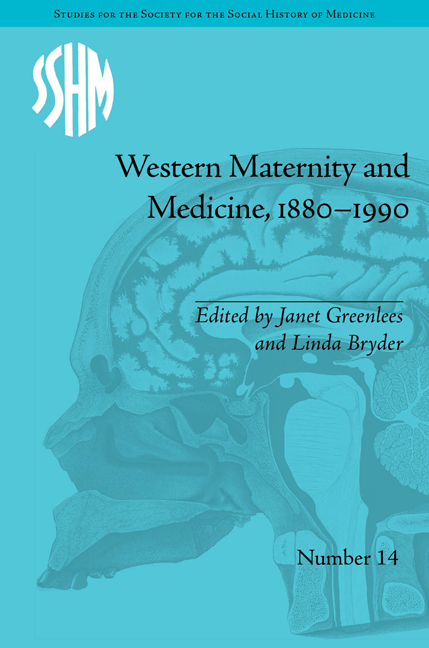Book contents
- Frontmatter
- CONTENTS
- Acknowledgements
- List of Contributors
- List of Tables
- Western Maternity and Medicine: An Introduction
- 1 Safely Delivered? Insights into Late Nineteenth-Century Australian Maternity Care from Coronial Investigations into Maternal Deaths
- 2 Pregnancy, Pathology and Public Morals: Making Antenatal Care in Edinburgh around 1900
- 3 ‘The Peculiar and Complex Female Problem’: The Church of Scotland and Health Care for Unwed Mothers, 1900–1948
- 4 Taking ‘Advantage of the Facilities and Comforts … Offered’: Women's Choice of Hospital Delivery in Interwar Edinburgh
- 5 ‘What Women Want’: Childbirth Services and Women's Activism in New Zealand, 1900–1960
- 6 'Twixt God and Geography: The Development of Maternity Services in Twentieth-Century Ireland
- 7 Test Tubes and Turpitude: Medical Responses to the Infertile Patient in Mid-Twentieth-Century Scotland
- 8 Women's Experiences of the Maternity Services in Berkshire and Oxfordshire, c. 1970–1990
- 9 From Muller to Johnson Controls: Mothers and Workplace Health in the US, from Protective Labour Legislation to Fetal Protection Policies
- Notes
- Index
5 - ‘What Women Want’: Childbirth Services and Women's Activism in New Zealand, 1900–1960
- Frontmatter
- CONTENTS
- Acknowledgements
- List of Contributors
- List of Tables
- Western Maternity and Medicine: An Introduction
- 1 Safely Delivered? Insights into Late Nineteenth-Century Australian Maternity Care from Coronial Investigations into Maternal Deaths
- 2 Pregnancy, Pathology and Public Morals: Making Antenatal Care in Edinburgh around 1900
- 3 ‘The Peculiar and Complex Female Problem’: The Church of Scotland and Health Care for Unwed Mothers, 1900–1948
- 4 Taking ‘Advantage of the Facilities and Comforts … Offered’: Women's Choice of Hospital Delivery in Interwar Edinburgh
- 5 ‘What Women Want’: Childbirth Services and Women's Activism in New Zealand, 1900–1960
- 6 'Twixt God and Geography: The Development of Maternity Services in Twentieth-Century Ireland
- 7 Test Tubes and Turpitude: Medical Responses to the Infertile Patient in Mid-Twentieth-Century Scotland
- 8 Women's Experiences of the Maternity Services in Berkshire and Oxfordshire, c. 1970–1990
- 9 From Muller to Johnson Controls: Mothers and Workplace Health in the US, from Protective Labour Legislation to Fetal Protection Policies
- Notes
- Index
Summary
The experience of childbirth has changed dramatically for most women in the Western world over the past one hundred years. There have been two major changes in that time. The first was a dramatic decline in the death rate for women in childbirth, which occurred from the 1930s. In the early twentieth century, such a death was a legitimate fear for anyone about to give birth. In New Zealand, the maternal death rate per 10,000 live births in 1927 was 44.1; by the late 1990s it was 2.5. The second major change was in the location of childbirth – from home to hospital. By the 1970s, hospital birth was the norm throughout most of the Western world. Were the two changes related? Some obstetricians and others would say they were, and that modern hospitals are the safest places for women to give birth. Irvine Loudon, an historian of maternal mortality, believes that memories are short, and that almost no-one now – including doctors and midwives – remembers those past dangers and realizes that the conquest of maternal mortality since the mid-1930s has been ‘one of the most remarkable achievements of modern medicine’.
Not all would agree. Achievements of modern medicine came under attack from the 1970s, when epidemiological studies showed that improvements in health had more do to with nutritional status and sanitation than with medical breakthroughs.
- Type
- Chapter
- Information
- Western Maternity and Medicine, 1880–1990 , pp. 81 - 98Publisher: Pickering & ChattoFirst published in: 2014

